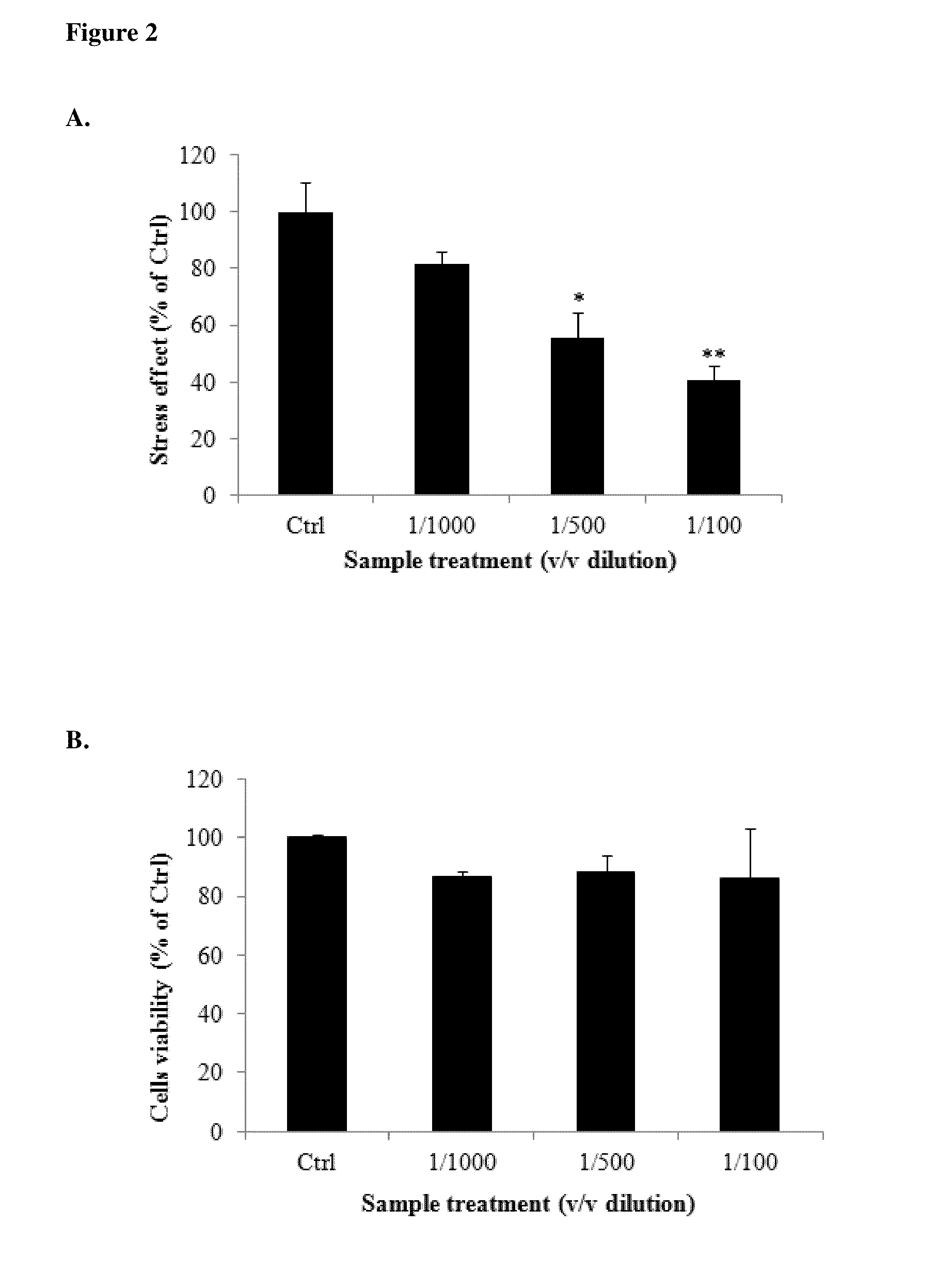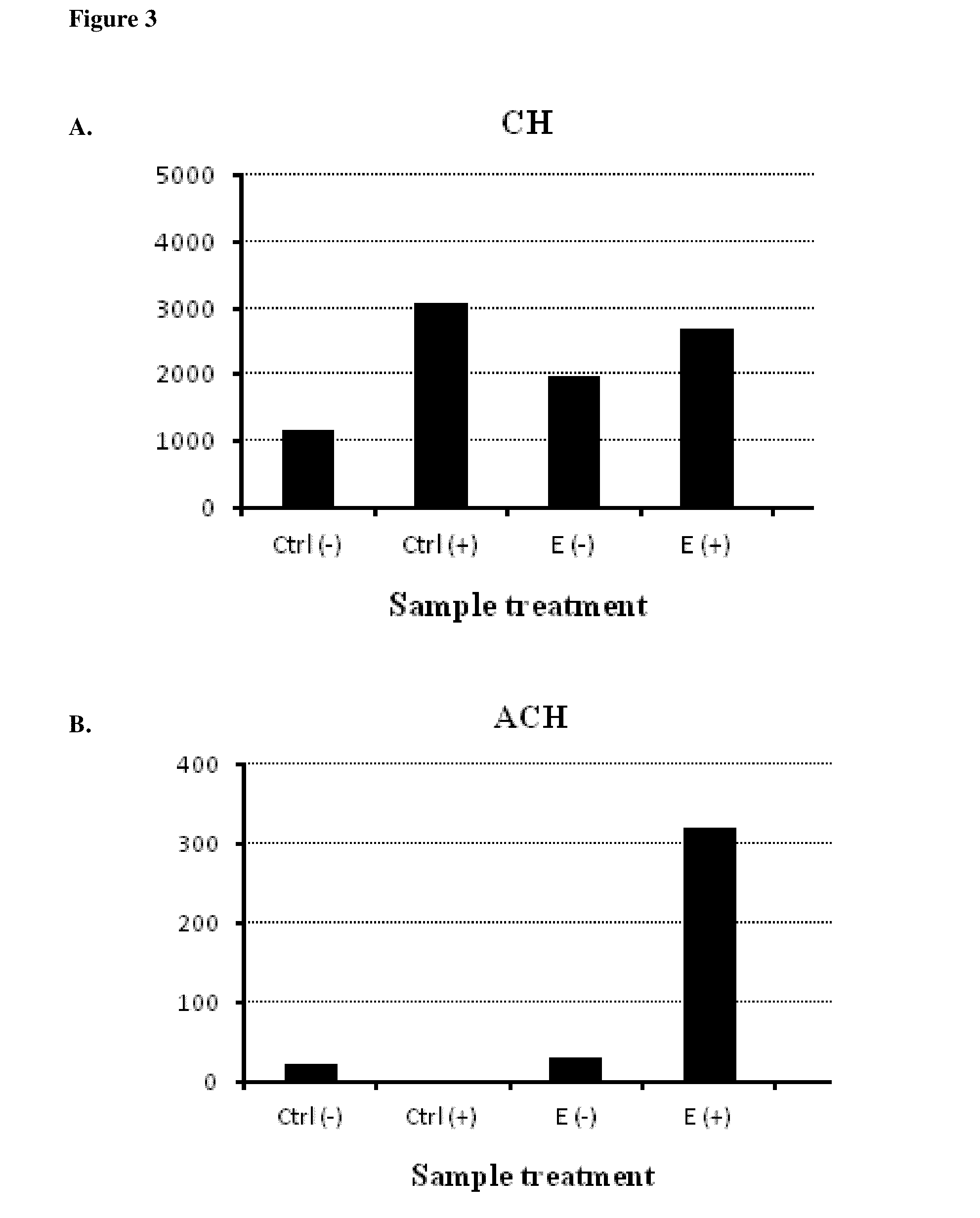Compositions and methods for treating emotional-psychological stress
a psychological stress and composition technology, applied in the field of compositions and methods for treating emotional psychological stress, can solve the problems of in vitro and in vivo anti-stress activity of it has not been demonstrated that ethanol extracts of i>c. schoenanthus /i>has anti-emotional-psychological stress activities, so as to reduce the probability o
- Summary
- Abstract
- Description
- Claims
- Application Information
AI Technical Summary
Benefits of technology
Problems solved by technology
Method used
Image
Examples
example 1
Exposure to C. Schoenanthus Ethanol Extracts does not Reduce Viability of SH-SY5Y Cells
[0055]To determine the concentration of C. schoenanthus ethanol extracts which can be used to investigate their anti-stress effect, SH-SY5Y cells were cultured with several concentrations (1 / 100, 1 / 1000, or 1 / 10000 v / v dilution of C. schoenanthus ethanol extract in culturing medium) for 72 hours. As shown in FIG. 1, none of the C. schoenanthus ethanol extracts concentrations were toxic to the SH-SY5Y cells. Actually, cell viability increased slightly compared to controls for 1 / 1,000 and 1 / 10,000 concentrations, although cell viability was slightly reduced when cells were treated with the 1 / 100 concentration.
example 2
In a Dose-Dependent Manner, Exposure to C. Schoenanthus Ethanol Extracts Reduces HSP47 Expression in Heat-Shocked Chinese Hamster Ovary Cells
[0056]To investigate the anti-stress effect of C. schoenanthus extracts, Chinese Hamster Ovary (CHO) cells were stably transfected with a construct comprising the Heat Shock Protein 47 (HSP47) promoter linked to the coding sequence for β-galactosidase. These cells were plated at 1×105 cells / ml and were stressed by heat shock for 90 min at 42° C., 5% CO2. After a two-hour recovery, cells were treated with C. schoenanthus ethanol extracts of different concentrations (1 / 100, 1 / 500, or 1 / 1000 v / v in medium) for three hours. FIG. 2A shows that HSP47 expression is significantly reduced in a dose-dependent manner. As shown in FIG. 2B, the viability of CHO cells was not reduced by treatment with C. schoenanthus ethanol extracts.
example 3
Exposure to C. Schoenanthus Ethanol Extracts Increases Acetylcholine Levels in Heat-Shocked SH-SY5Y Cells
[0057]There are direct relationships between stress and neurotransmitter (e.g., Acetylcholine, Dopamine, Norepinephrine, Glutamate, and Serotonin) release. Additionally, there is a link between acetylcholine and Alzheimer's disease: there is approximately a 90% loss of acetylcholine in the brain of one suffering from Alzheimer's disease.
[0058]As shown in FIG. 3A, levels of choline (“CH”) appear to be unaffected by heat shock and / or exposure to C. schoenanthus ethanol extracts. In contrast, as seen in FIG. 3B (“E(+)”), exposure to C. schoenanthus ethanol extracts (at a 1 / 1000 v / v dilution in medium) increases acetylcholine (“ACH”) levels in heat-shocked SH-SY5Y cells. Cells that were not heat shocked or exposed to ethanol extracts (“Ctrl(−)”); cells that were heat shocked but not exposed to ethanol extracts (“Ctrl(+)”), and cells that were not heat shocked cells but were exposed t...
PUM
 Login to View More
Login to View More Abstract
Description
Claims
Application Information
 Login to View More
Login to View More - R&D
- Intellectual Property
- Life Sciences
- Materials
- Tech Scout
- Unparalleled Data Quality
- Higher Quality Content
- 60% Fewer Hallucinations
Browse by: Latest US Patents, China's latest patents, Technical Efficacy Thesaurus, Application Domain, Technology Topic, Popular Technical Reports.
© 2025 PatSnap. All rights reserved.Legal|Privacy policy|Modern Slavery Act Transparency Statement|Sitemap|About US| Contact US: help@patsnap.com



